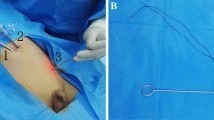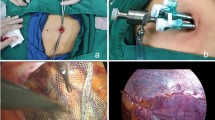Abstract
Purpose
Laparoscopic percutaneous extraperitoneal closure (LPEC) has become routine for repairing pediatric inguinal hernia (IH). Reports on the effective repair of IH in challenging cases, such as extremely low birth weight infants (ELBWI) who become symptomatic soon after birth and have surgery before 1 year of age, are rare; and conventional herniotomy (CH) in ELBWI requires extensive experience of neonatal surgery. We compared LPEC with CH for treating ELBWI with IH.
Methods
Consecutive ELBWI with IH treated by either LPEC (n = 17) or CH (n = 22) before 1 year of age between 2012 and 2017 were reviewed. LPEC were performed by consultant pediatric surgeons (CPS; n = 3) with experience of at least 200 cases each. In CH, 11 cases were treated by CPS and 11 by CPS-supervised surgical trainees.
Results
There were no intraoperative complications. Operative time and anesthesia time for bilateral IH repairs were both shorter in LPEC. Postoperative sequelae were recurrence (LPEC; n = 1; repaired by redo LPEC 2 months after the initial repair) and intravenous rehydration (CH; n = 1; for persistent post-anesthetic vomiting). Recovery was unremarkable in all cases without additional analgesia.
Conclusion
LPEC would appear to be a viable option for treating IH in ELBWI, especially bilateral cases.



Similar content being viewed by others
References
Esposito C, Escolino M, Turra F, Roberti A, Cerulo M, Farina A et al (2016) Current concepts in the management of inguinal hernia and hydrocele in pediatric patients in laparoscopic era. Semin Pediatr Surg 25:232–240
Schier F (1998) Laparoscopic herniorrhaphy in girls. J Pediatr Surg 33:1495–1497
Takehara H, Yakabe S, Kameoka K (2006) Laparoscopic percutaneous extraperitoneal closure for inguinal hernia in children: clinical outcome of 972 repairs done in 3 pediatric surgical institutions. J Pediatr Surg 41:1999–2003
Endo M, Watanabe T, Nakano M et al (2009) Laparoscopic completely extraperitoneal repair of inguinal hernia in children: a single-institute experience with 1,257 repairs compared with cut-down herniorrhaphy. Surg Endosc 23:1706–1712
Miyake H, Fukumoto K, Yamoto M, Nouso H, Kaneshiro M, Nakajima H et al (2016) Comparison of percutaneous extraperitoneal closure (LPEC) and open repair for pediatric inguinal hernia: experience of a single institution with over 1000 cases. Surg Endosc 30:1466–1472
Sachs M, Damm M, Encke A (1997) Historical evolution of inguinal hernia repair. World J Surg 21:218–223
Pini Prato A, Casaccia G, Arnoldi R (2017) Timing and management of inguinal hernia in the premature baby. Eur J Pediatr Surg 27:472–477
Turial S, Enders J, Krause K, Schier F (2010) Laparoscopic inguinal herniorrhaphy in premature infants. Eur J Pediatr Surg 20:371–374
Allen GS, Cox CS Jr, White N, Khalil S, Rabb M, Lally KP (1998) Postoperative respiratory complications in ex-premature infants after inguinal herniorrhaphy. J Pediatr Surg 33:1095–1098
Kokorowski PJ, Wang HH, Routh JC, Hubert KC, Nelson CP (2014) Evaluation of the contralateral inguinal ring in clinically unilateral inguinal hernia: a systematic review and meta-analysis. Hernia 18:311–324
Shono T, Izaki T, Nakahori R, Yoshimaru K (2015) Testicular ascent after laparoscopic percutaneous extraperitoneal closure for inguinal hernias. Eur J Pediatr Surg 25:105–108
Wang F, Zhong H, Zhao J (2017) Ascending testis after repair of pediatric inguinal hernia and hydrocele: a misunderstood operative complication. J Pediatr Urol 13:53.e1–53.e5
Funding
This research did not receive any specific grant from funding agencies in the public, commercial, or not-for profit sectors.
Author information
Authors and Affiliations
Corresponding author
Rights and permissions
About this article
Cite this article
Shibuya, S., Miyazaki, E., Miyano, G. et al. Comparison of laparoscopic percutaneous extraperitoneal closure versus conventional herniotomy in extremely low birth weight infants. Pediatr Surg Int 35, 145–150 (2019). https://doi.org/10.1007/s00383-018-4386-2
Accepted:
Published:
Issue Date:
DOI: https://doi.org/10.1007/s00383-018-4386-2




